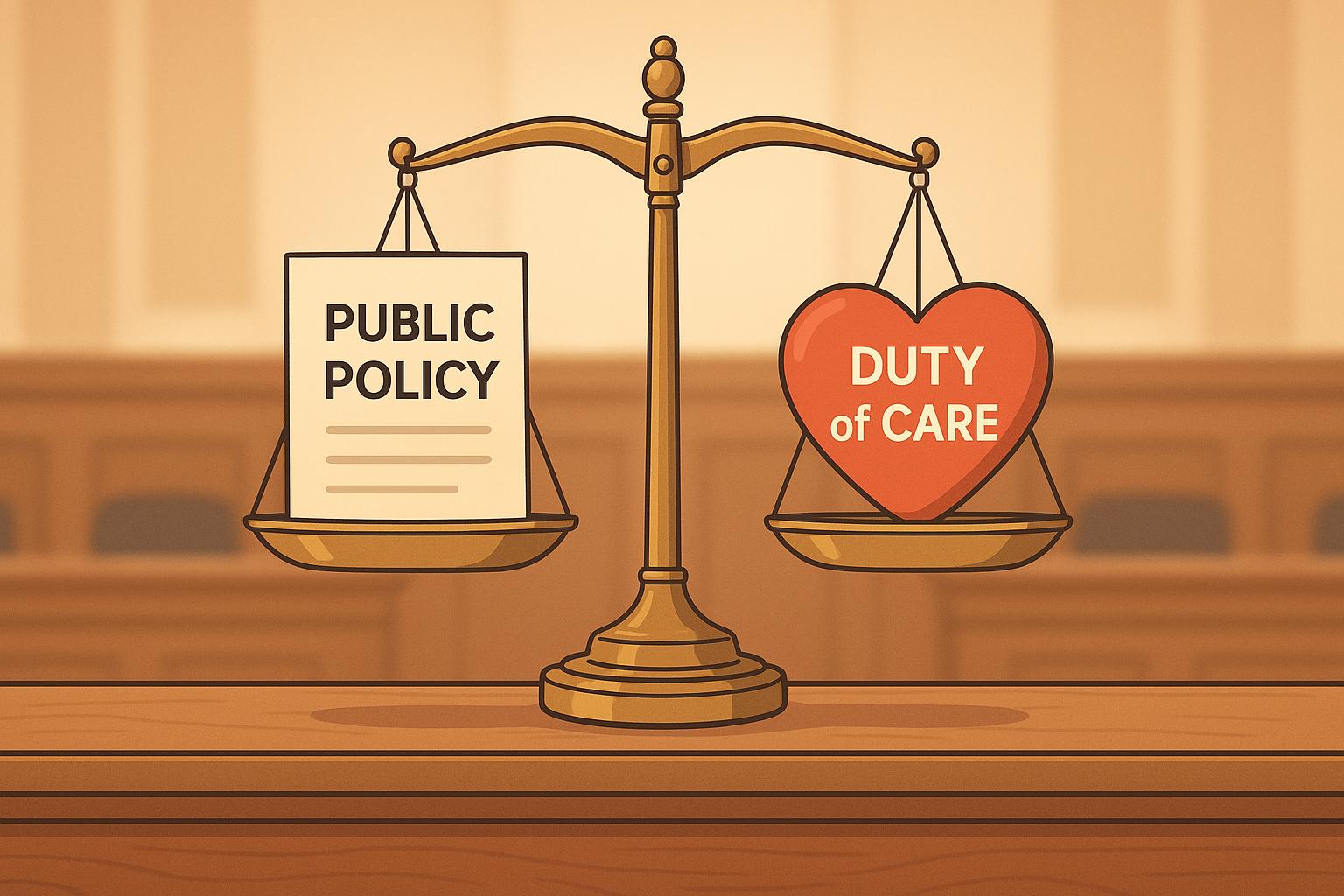Public policy helps shape the legal responsibilities individuals and organizations have to prevent harm to others, known as "duty of care." This concept is critical in personal injury cases and evolves with societal changes, such as new technologies and shifting norms. Here’s what you need to know:
- Key Factors in Duty of Care: Courts consider foreseeability of harm, relationships between parties, the balance of risk vs. prevention, and broader societal impacts.
- Regulations Matter: Federal and state rules, like OSHA for workplace safety or building codes for property management, set clear standards for liability.
- Legal Challenges: Courts balance protecting injured parties with keeping liability reasonable for defendants, often referencing economic burden, public safety, and industry standards.
- How Cases Are Handled: Success depends on staying updated on laws, working with expert witnesses, and collecting strong evidence like detailed records and policy compliance.
Public policy ensures duty of care standards align with societal needs, making it essential to stay informed and prepared when navigating these cases.
Public Policy Effects on Duty of Care Standards
Public policy plays a crucial role in how courts and legal experts interpret duty of care standards. These standards shift over time due to changes in legislation and judicial decisions. Below are the key principles that influence these standards.
Key Principles Shaping Duty of Care
Certain policy principles help determine when and how a duty of care applies. These include:
- Foreseeability of harm: Could the harm have reasonably been predicted?
- Relationship between parties: How closely connected are the involved individuals or entities?
- Burden versus likelihood: Does the effort to prevent harm outweigh the risk of injury?
- Social impact: What are the broader societal consequences of imposing a duty?
In healthcare, for instance, standards like maintaining accurate patient records, obtaining informed consent, and responding to emergencies protect patients while offering clear guidelines for providers.
Federal and State Regulations
Both federal and state rules establish baseline duty of care standards across different industries. Here’s a breakdown of some key regulatory areas:
| Regulatory Area | Primary Standards | Impact on Duty of Care |
|---|---|---|
| Workplace Safety | OSHA Guidelines | Defines employer responsibilities for safety |
| Transportation | DOT Regulations | Sets safety rules for commercial carriers |
| Property Management | Building Codes | Requires adherence to minimum safety measures |
State laws often expand on federal rules, introducing stricter safety measures, detailed reporting requirements, mandatory training, and higher insurance thresholds. These additional layers of regulation ensure a more tailored approach to managing risks within specific regions.
Common Legal Issues in Duty of Care
Legal challenges often emerge where public policy and duty of care intersect. Courts need to protect injured parties while ensuring that liability standards remain reasonable for defendants.
Setting Duty Boundaries
Courts carefully weigh public policy goals against practical liability limits. Several factors play a role in shaping these boundaries:
| Factor | Policy Consideration | Legal Impact |
|---|---|---|
| Economic Burden | Cost of preventive measures | Courts evaluate if the required measures would impose excessive financial strain. |
| Public Safety | Community protection needs | Stricter standards are typically applied in cases involving public welfare. |
| Industry Standards | Established practices | Courts reference typical industry protocols when defining boundaries. |
| Resource Allocation | Available institutional capacity | Expectations are assessed based on the resources realistically available. |
One influential case in this area is Tarasoff v. Regents of the University of California (1976). This ruling highlighted the obligation of professionals to act when there is a foreseeable risk of harm, particularly in situations involving public safety. These factors help courts define the scope of legal duty.
Establishing Legal Duty
Once boundaries are set, courts follow a three-step process to determine if a legal duty exists:
- Relationship Analysis: Examine the connection between the parties to identify any special responsibilities that may arise.
- Risk Assessment: Assess the likelihood and potential severity of harm to justify imposing a duty, ensuring alignment with public policy.
- Public Policy Impact: Consider whether recognizing a duty supports broader safety goals and protects vulnerable groups.
This structured approach allows courts to assign duties in a way that is fair and aligned with public policy priorities.
Handling Duty of Care Cases
Managing duty of care cases requires staying aligned with changes in public policy. These practices build on the public policy framework discussed earlier.
Keeping Up with Legal Updates
It’s essential to regularly update practices to align with changing standards. Here’s how:
- Stay informed about new laws and regulatory updates.
- Track recent court rulings that may affect duty of care cases.
- Adjust case strategies to reflect the latest policies and legal interpretations.
Collaborating with Expert Witnesses
Expert witnesses play a key role in assessing duty of care standards and strengthening case strategies. To make the most of their input, legal teams should:
- Engage Early: Bring in experts early in the process to help identify critical policy issues.
- Review Documentation: Ensure guidelines and standards are thoroughly reviewed to align with current policies.
- Analyze Standards of Care: Compare actions in the case against established care standards to evaluate compliance effectively.
sbb-itb-68ed374
Client-Focused Legal Support
Handling duty of care cases requires precise legal guidance tailored to each client’s unique situation. At Ocala Injury Law, we understand the importance of providing personalized support that aligns with current legal standards.
We start by thoroughly evaluating the factors influencing your case. This includes analyzing state and federal regulations, reviewing relevant precedent, and assessing the influence of public policy. This groundwork helps us build a strong foundation for gathering evidence and documentation. Our clients gain clarity on:
- How public policy affects their case
- The legal standards and requirements that apply
- The critical evidence needed to support their position
- Strategies specifically designed for their situation based on current interpretations of the law
Clear and consistent communication is at the heart of our approach. We keep you updated on changes in policy, explain legal terms in plain language, and ensure you fully understand your rights and responsibilities throughout the process.
To strengthen your case, we emphasize accurate documentation and evidence collection. We assist you in key areas, such as:
-
Keeping Detailed Records
Maintain a chronological log of all relevant events and communications. These records can be vital in demonstrating compliance with legal standards. -
Organizing Supporting Evidence
Collect and arrange evidence that shows adherence to public policy and industry standards. This may include official documents, witness statements, or expert opinions. -
Tracking Policy Compliance
Document how actions align with current public policy and legal standards. This detailed record-keeping not only strengthens your case but also reflects our commitment to meeting all legal requirements.
With tailored strategies and open communication, Ocala Injury Law ensures that you receive the focused legal support needed to navigate the complexities of duty of care cases effectively.
Conclusion
Effective legal support and detailed evidence collection play a key role in shaping duty of care standards. Public policy significantly influences these standards in personal injury cases across the United States, creating guidelines that shape legal decisions.
Staying informed about public policy’s role in defining duty of care is essential for achieving favorable outcomes. Recent changes in state and federal regulations have introduced new challenges across industries like healthcare and property management. These shifts demand careful interpretation and application within existing legal frameworks.
Accurate documentation and expert analysis are critical to ensuring that duty of care cases align with current legal standards and protect clients’ rights. At Ocala Injury Law, we understand that every case brings its own set of challenges. Our strategy combines in-depth policy evaluation with comprehensive case analysis to develop strong legal arguments.
Resolving duty of care cases successfully requires more than technical knowledge – it demands practical application of evolving legal standards. Experienced attorneys simplify the process by skillfully navigating these changes. In a constantly shifting legal environment, understanding public policy is essential to achieving fair and just outcomes in personal injury cases.
FAQs
How does public policy shape duty of care standards in personal injury cases, especially with advancements in technology and societal changes?
Public policy plays a crucial role in shaping duty of care standards by ensuring they evolve alongside technological advancements and societal shifts. For instance, as new technologies like autonomous vehicles or artificial intelligence emerge, public policy helps define how responsibility is assigned, ensuring safety and accountability remain priorities.
This dynamic approach allows the legal system to address modern challenges while balancing individual rights and community welfare. If you’re navigating a personal injury case, understanding these evolving standards is essential. Legal experts, like those at Ocala Injury Law, can provide guidance tailored to your unique situation, ensuring your rights are protected and your case is handled with care.
How do expert witnesses help strengthen duty of care cases in personal injury lawsuits?
Expert witnesses play a crucial role in personal injury cases involving duty of care by providing specialized knowledge and credible testimony. They help clarify complex issues, such as establishing whether a defendant’s actions met the standard of care expected in a given situation. For example, a medical expert might testify about whether a healthcare provider acted negligently, or an accident reconstruction expert could explain the cause of a car crash.
To effectively utilize expert witnesses, it’s important to ensure they have strong credentials, relevant experience, and the ability to communicate their findings clearly to a jury. Their testimony can significantly impact the outcome of a case by helping to establish liability and prove damages. Working with a skilled legal team, like those at Ocala Injury Law, ensures expert witnesses are selected and prepared to support your case effectively.
What steps can individuals and organizations take to comply with federal and state regulations related to duty of care in personal injury cases?
To comply with federal and state regulations regarding duty of care, individuals and organizations should focus on understanding and adhering to the specific legal standards that apply to their circumstances. This often involves staying informed about relevant laws, maintaining proper safety protocols, and addressing potential risks proactively.
For organizations, implementing comprehensive training programs, conducting regular safety audits, and ensuring proper documentation can help demonstrate compliance. Individuals should remain aware of their responsibilities in various situations, such as driving safely or maintaining safe premises. Consulting with an experienced personal injury attorney, like those at Ocala Injury Law, can provide valuable guidance tailored to your unique situation.




